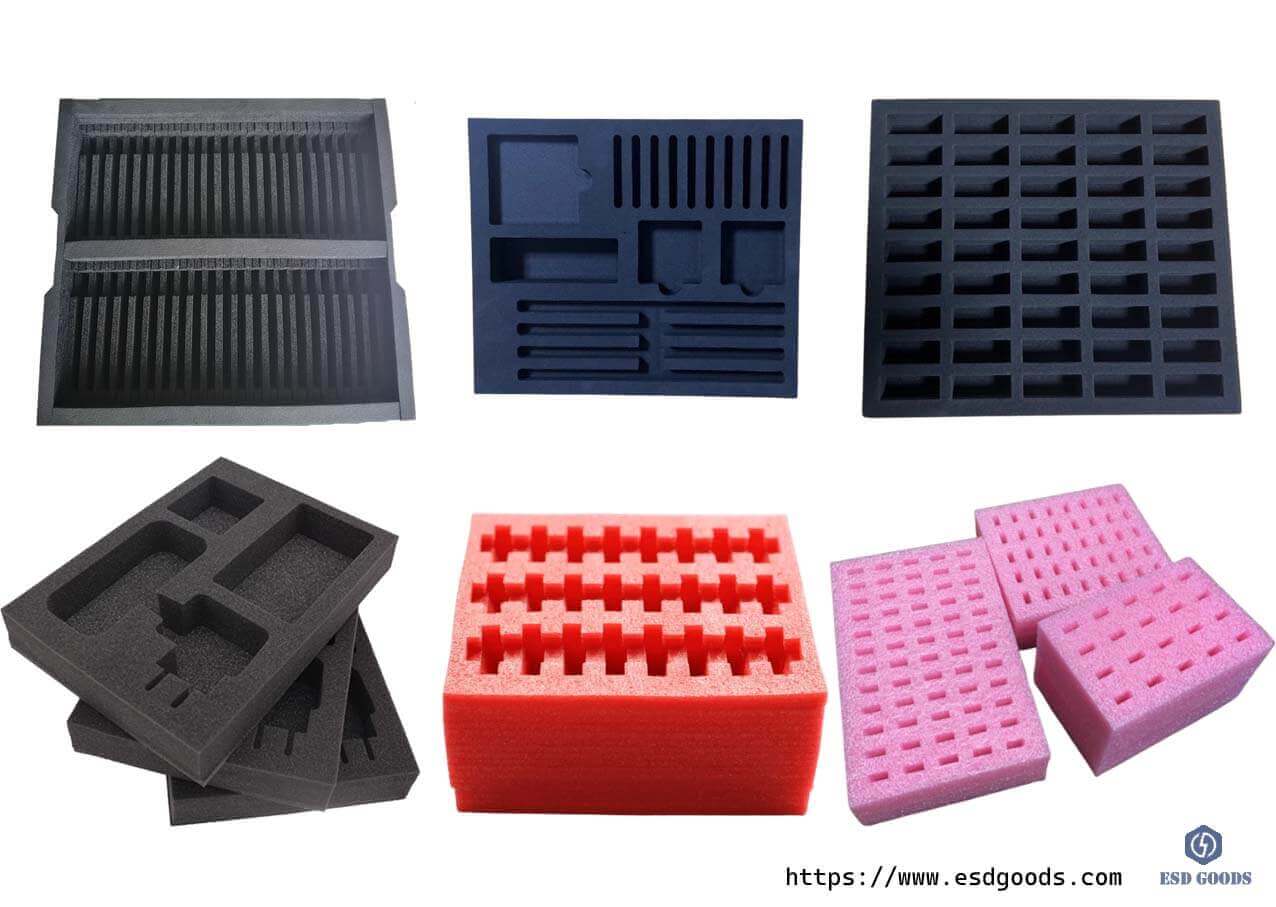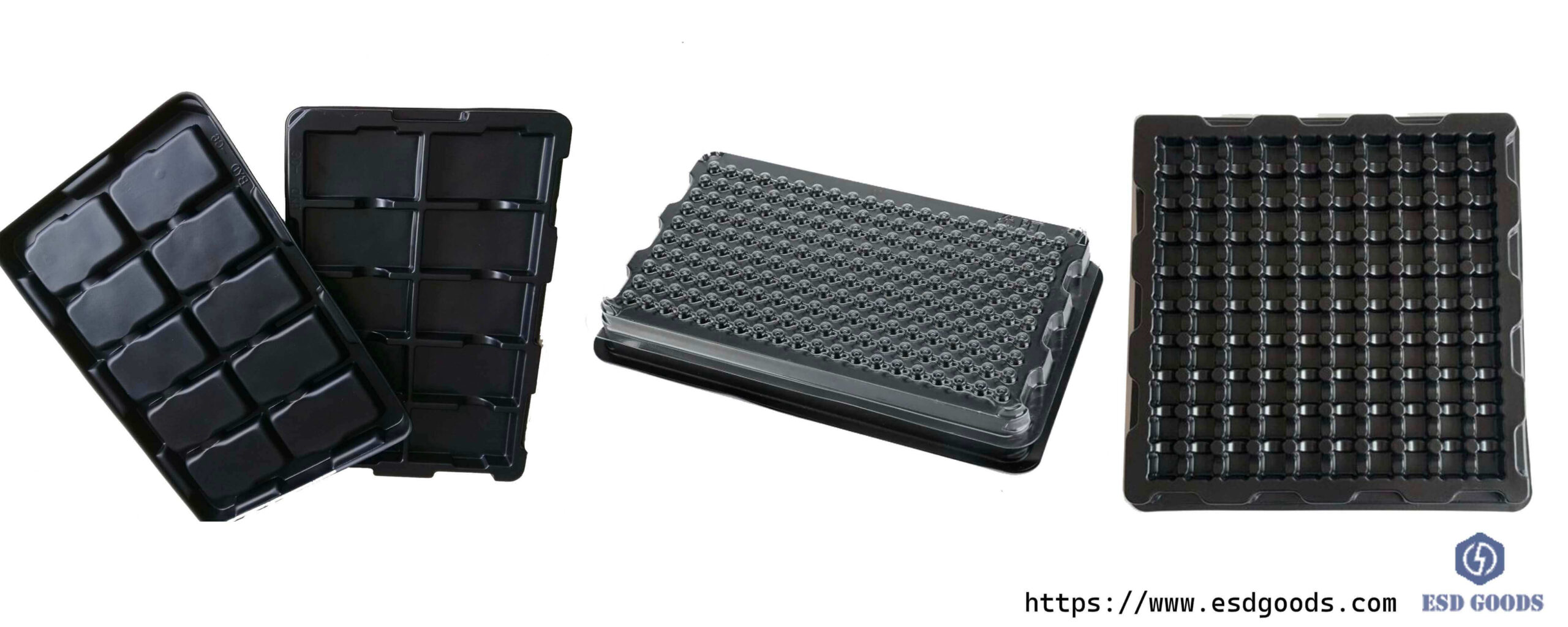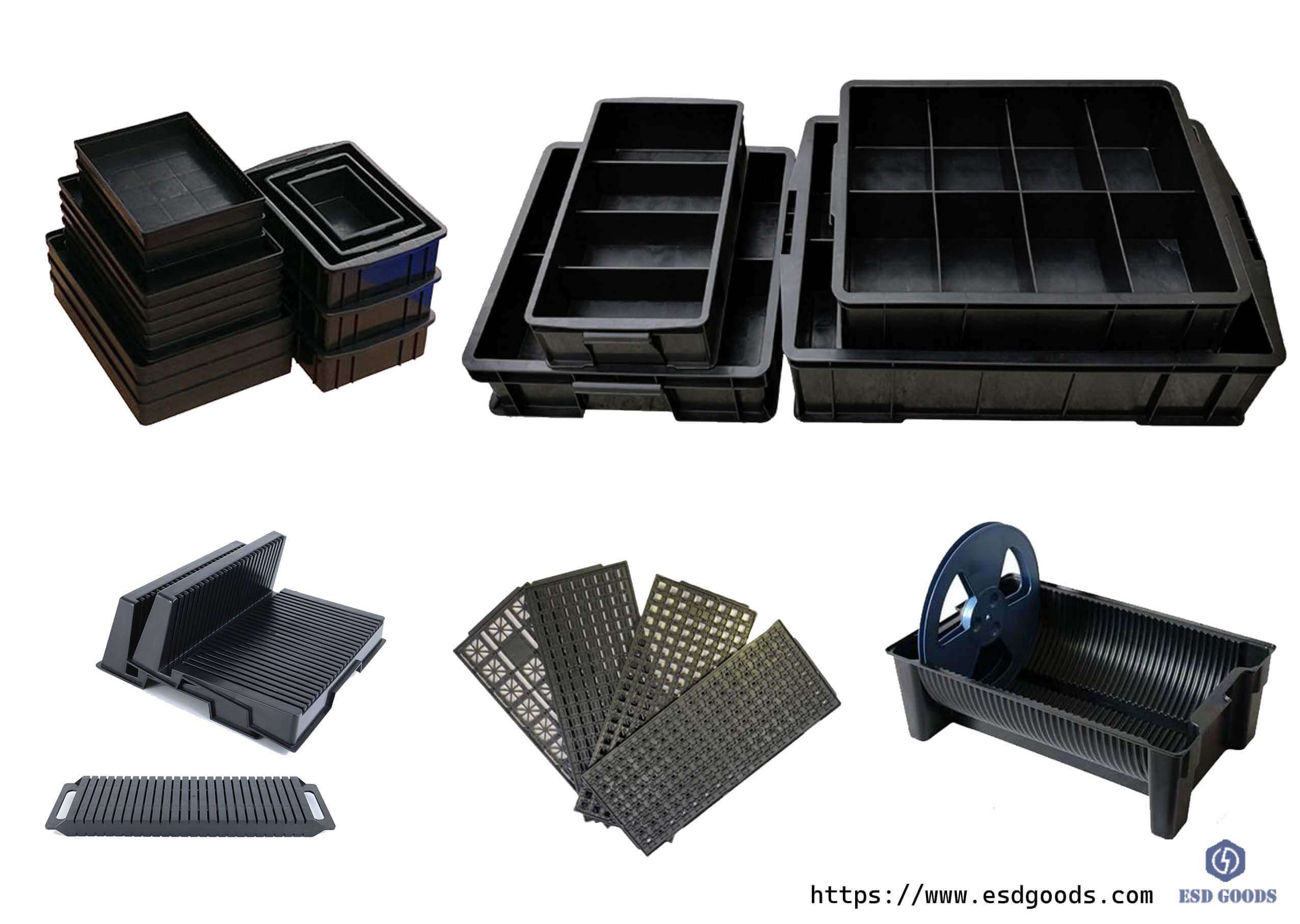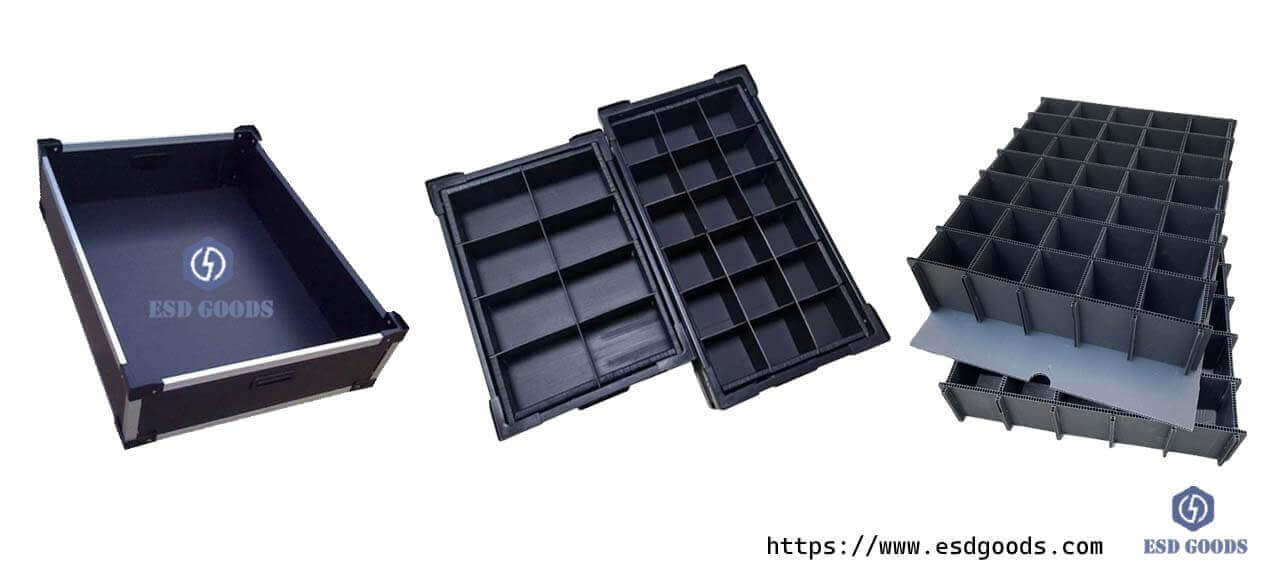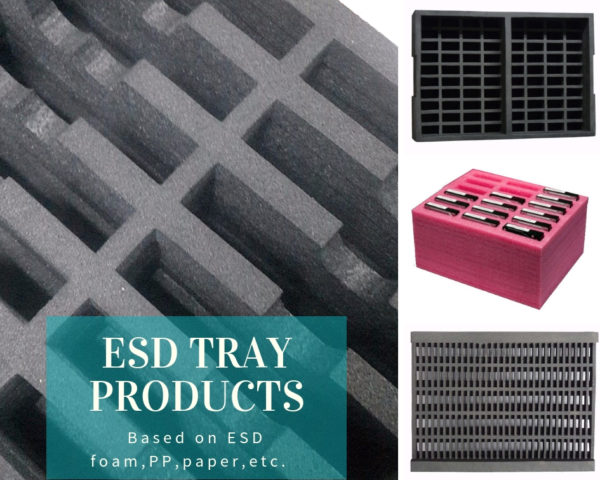How to Choose the right ESD Trays for Protecting Electronics?
In today's technology-driven world where electronic devices are widely available, it is critical to protect sensitive components during storage, transportation and assembly. Electrostatic discharge (ESD) poses a significant threat to electronic components and can cause irreparable damage and failure. To minimize this risk, industries rely on specialized tools and equipment, of which ESD trays are an essential part of the protection measures.
What are ESD Trays?
ESD trays, also known as anti-static trays or conductive trays, are specially designed containers used for storing and transporting electronic components that are susceptible to damage from electrostatic discharge. These trays are constructed from materials that dissipate electrostatic charges, preventing them from building up and potentially harming sensitive components.
The Working Principle of Anti-static Trays
The anti-static working principle of the anti-static plastic pallet is to prevent static electricity by accumulating electricity and provide a safe and controlled environment for electronic components, When the electrostatic charge, electrons will accumulate on the surface of the object, forming a localized charge. The presence of antistatic plastic tray conductive particles or fibers can guide these accumulated electrons to the ground, the discharge prevents static electricity to electronic components caused by damage. These trays are designed with features that facilitate proper handling, storage, and transportation of delicate components.
What’s Types of ESD Trays ?
Static dissipative trays are typically made from materials with specific static dissipative properties. Common materials include conductive anti-static foams, polyolefin materials, conductive plastics, carbon-filled polymers or composites containing conductive additives. These materials allow the tray to safely conduct static electricity away from components and prevent damage.
Among the many options available, there are several different types of antistatic trays to meet different industry needs and specifications. The main types are as follows: Antistatic foam trays, Antistatic polypropylene blister trays, Antistatic polypropylene injection molded trays and Antistatic foam injection molded trays.
| Item | Foam Tray | Blister Tray | PP Injection molded Tray | Corrugated Tray | Foam Injection Molded Tray |
| Material | PU/PE/EVA/EPE | PP/PS/PET | PP | PP | PP |
| Color | Black/Pink/Red | Black/Transparent | Black | Black | Black |
| Conductive Value | 10^3-10^5 | 10^3-10^5 | 10^4-10^9 | 10^3-10^5 | 10^5-10^8 |
| ESD Value | 10^6-10^9 | 10^6-10^9 | 10^6-10^9 | ||
| Customize | Yes
low cost |
Yes
Medium Cost |
Yes
High cost |
Yes
Low cost |
Yes
High cost |
1. ESD Foam Trays
ESD Foam Trays are made of specialized foam materials with inherent static dissipative properties. These trays provide excellent cushioning and protection for delicate electronic components during storage and transportation. Not only does the foam dissipate static electricity, but it also dampens vibration and minimizes the risk of physical damage. ESD foam trays are especially suited for fragile components or irregularly shaped items that require a tight and secure fit.
2. ESD Blister Trays
ESD blister trays are thermoformed containers made of conductive polyolefin/PET material. These trays have a blister-like structure with internal compartments or cavities that securely hold individual electronic components. ESD blister trays provide excellent ESD protection while keeping stored components visible and easily accessible. Their lightweight and durable construction makes them ideal for high-volume production environments where efficiency and reliability are paramount.
3. ESD PP Injection Molded Trays
ESD PP injection molded trays are manufactured using an injection molding process to provide rugged, precisely designed containers for electronic components. Made from conductive polypropylene material with static dissipative additives, these trays are available in a variety of sizes and configurations. Their uniformity and consistency make them suitable for automated assembly processes, ensuring accuracy and repeatability. The products are cost effective to customize and the right size can be selected from those available.
4. ESD Corrugated Trays
ESD corrugated trays are made of conductive corrugated material and are a lightweight yet rugged solution for ESD protection. Versatile and cost-effective for a wide range of applications, ESD corrugated trays are commonly used in industries where large quantities of static-sensitive components need to be transported or stored to provide reliable protection against electrostatic discharges. he low cost of product customization makes them ideal for customers with size requirements but small order quantities.
5. ESD Foam Injection Molded Trays
ESD Foam Injection Molded Trays combine the benefits of foam with precision injection molding technology to provide superior protection and customization. These trays are made by injecting specialized foam material into custom molds that are shaped and sized to exactly match the components being stored. ESD Foam Injection Molded Trays offer excellent ESD protection, cushioning, and insulation, making them ideal for sensitive electronic components that require delicate handling. Product customization is costly and requires selecting from the supplier's available sizes.
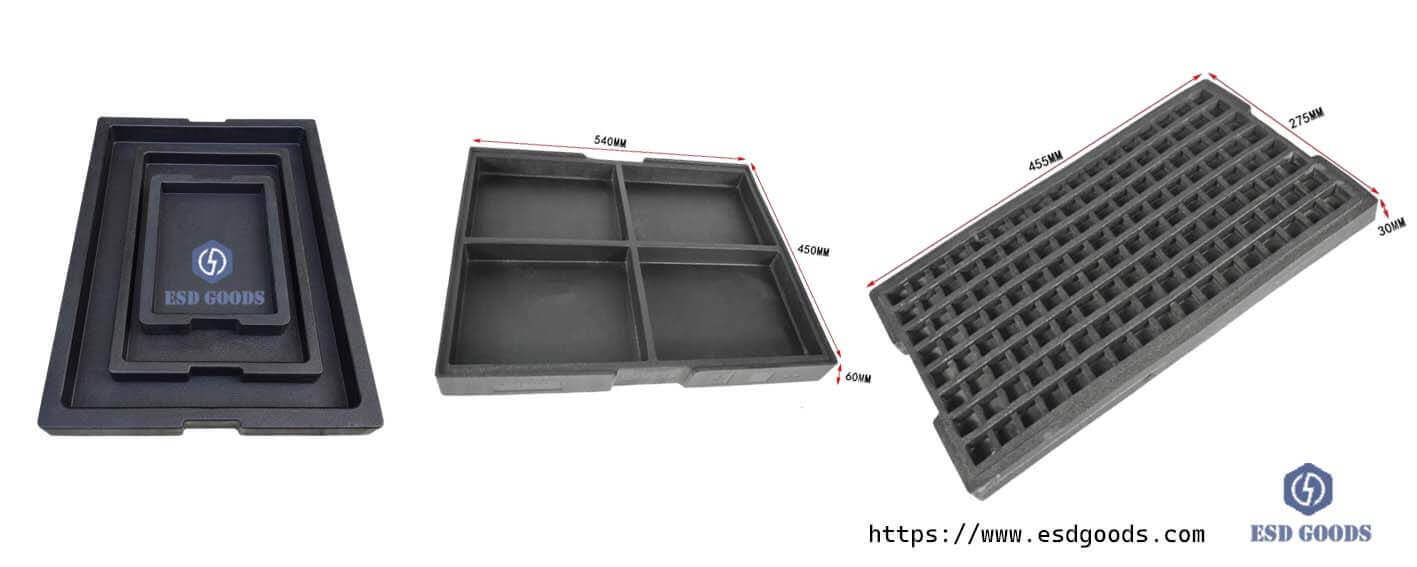
How to Choose the Right ESD Tray
Choosing the right ESD tray depends on a variety of factors, including the nature of the electronic components, industry requirements, and operational considerations. Each type of ESD tray has unique advantages and applications. Trays can be used individually or in combination to ensure the integrity of the electronic components being packaged, and manufacturers can choose different combinations of trays for packaging depending on their specific needs.
Benefits of ESD Trays
ESD Protection: The primary advantage of ESD trays is their ability to safeguard electronic components from electrostatic discharge, ensuring their integrity and functionality.
Organization and Efficiency: By providing a structured and secure storage solution, ESD trays help streamline inventory management and assembly processes, reducing the risk of errors and mishandling.
Cost Savings: Protecting electronic components from ESD damage can significantly reduce the risk of product defects and failures, ultimately saving manufacturers time and money on costly rework or replacements.
Compliance: Many industries, particularly those in electronics manufacturing and assembly, are subject to strict quality standards and regulations. Using ESD trays demonstrates compliance with these standards, enhancing the reputation and reliability of the products.
Environmental Sustainability: ESD trays are often reusable and recyclable, contributing to environmental sustainability by reducing waste and promoting responsible resource management.
Applications of ESD Trays
ESD trays are used in a variety of industries where the protection of electronic components is critical. Some common applications include
- Electronics Manufacturing: ESD trays are widely used in the manufacturing of electronic devices such as computer hardware, consumer electronics and automotive electronics.
- Semiconductor Industry: In semiconductor manufacturing facilities, ESD trays play a critical role in protecting precision silicon wafers and semiconductor components from electrostatic damage.
- Medical Device Manufacturing: Medical device manufacturers rely on ESD trays to protect sensitive electronic components used in devices such as diagnostic equipment, monitoring equipment and surgical instruments.
- Aerospace and Defense: In aerospace and defense applications, where reliability and performance are critical, ESD trays ensure the integrity of electronic components used in avionics, navigation systems and communications equipment.
Maintenance of anti-static plastic trays
(1) Avoid moisture: anti-static plastic trays are easy to absorb moisture, once damp, it will reduce the antistatic properties of the tray, so moisture should be avoided.
(2) Avoid heavy pressure: anti-static plastic trays are not as strong as wooden and metal trays, and should not be subjected to heavy pressure.
(3) Avoid direct sunlight: prolonged exposure to sunlight will make the anti-static plastic trays aging and deformation, reducing its anti-static properties.
Conclusion
In the ever-evolving world of electronics manufacturing and technology, the importance of protecting sensitive components from electrostatic discharge cannot be overemphasized. ESD trays are a vital line of defense against this pervasive threat, ensuring the integrity, reliability and performance of electronic equipment. By understanding the role and benefits of ESD trays, industries can take strong measures to protect their investments and deliver quality products to consumers. More information,please visit https://www.esdgoods.com.

